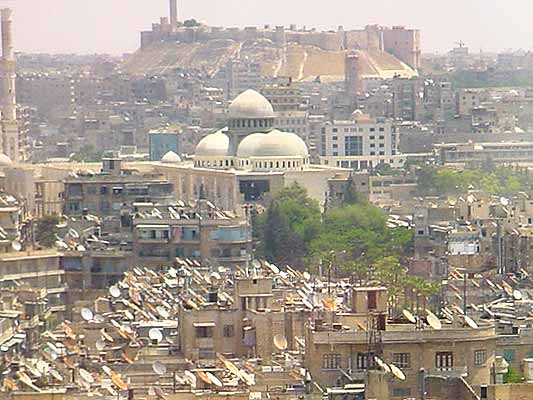Aleppo’s various communities live in peace, mutual understanding and respect, in spite of the different religions, beliefs or creeds that mark the population of the city in a way likened to a folklore portrait, or a mosaic masterpiece.
Historical Background:
During the ancient pagan ages Aleppo enjoyed a high religious position because most of its kings believed in the Gods of Aleppo. Historical archives indicate that Zimrilim, king of Mari used to offer sacrifices to Hadad, Aleppo’s God in the temple of Kallaso, now al Kallaseh quarter.
Foreign conquerors of the city used to worship Hadad and Atar Ghatis (Ishtar). When the Aleppines embraced monotheistic faiths they showed every respect and tolerance to the beliefs of the others. Although the majority of the Aleppines now are Moslems, they have opened their arms and hearts to new comers of other faiths and religions and showed full respect to their traditions and rites of worship. Those who settled in Aleppo, lived, generation after generation, enjoyed peace and full equality. The Franciscans came to Aleppo in 1237, lived in Bab Antakiya and then in Khan al Saboun and al Aziziya. The Carmelites followed, and lived in Khan al Jumrok. The Cappuccines came to Aleppo in 1623 and lived in Khan al Qassabieh.
The Jesuits came in 1625 and the Anglicans in 1850…etc. Aleppo is the only city in the world where 11 Christian communities live, proud of their Arab origins. Orthodox Archbishop Gregarious Haddad says: “We, Christians of this country, are Arab Ghassanids.We feel that our Arab nationalism invokes us to live hand in hand with our Moslem brothers in this Arab Country we chose to live in.” It was locally acknowledged that in each of Aleppo’s large khans there used to be a mosque, a church and a synagogue. Moslems of Aleppo: Islam spread in Aleppo when the Moslem commander Abou Ubaida al Jarrah entered the city peacefully in 636 AD. He applied the Waqf (endowment) system on 36 % of the real estates of Aleppo’s markets.
This included 4000 trading shops. Later, schools (madrasas) were established namely: al Sultaniyya, al Ridaiyya, al Khisrawiyya, al Halawiyya, al Fardossiya and al Sharafiyya in addition to the mosques (namely the Umayyad, al Qiqan, al Touta, Mashhad al Husein, al Tawashi, al Atrouch, al Adeliyya….etc) and almshouses (takaya). Christians of Aleppo: It is said that Christianity entered Aleppo through Antioch, on the hands of Simeon the Jealous, one of the 12 apostles. Aleppo’s Bishopric occupied a high position in the region when Helen of Antioch, mother of Emperor Constantine built a church in Aleppo, now Madrasa al Halawiyya.
Four popes from Syria sat on the Papal Seat in Rome in the 7th and 8th centuries. Monks and missionaries arrived with European merchants in 1233, established their own monasteries, and in 1702 Archbishop Ithnasious Dabbas brought the first Arabic printing machine to the east to help this profession start in the region. Jews of Aleppo: The oldest Jewish synagogue is still preserved in the quarter of al Bandara. The synagogue was built in the 5th century AD where there is now the Shrine of St. George locally known as al Khodr.
There is another synagogue in al Jamiliyya quarter near al Samawaal. Many Jews who departed to Palestine, returned to Aleppo after they had realized the difference between Judaism and Zionism. These slices of the society of Aleppo live like a united family, subjects to the civil laws of the state in full equality. Concerning religious affairs, each community has its own systems, establishments, endowments, schools and courts.The religion or faith is not mentioned on Syrian identity cards. It is registered only in civil registers for certain civil applications.
Haifaa Mafalani

